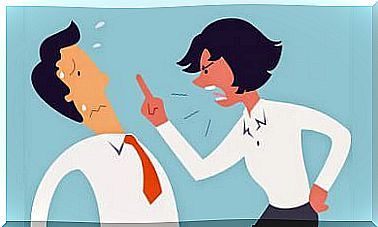What Is Fear For?

Fear or fear is one of the six basic emotions (joy, sadness, disgust, anger, fear, surprise) described by Charles Darwin in 1872 and which has a well-differentiated gesture: open eyes, a trembling mouth and a feeling of perplexity. Now, what is fear for?
Although we all experience this emotion throughout our lives, many of us are not very clear about its function – if it exists – and what message it wants to convey to us. Because what would become of us if fear did not exist? Is a free life possible this emotion? Let’s see it.
Fear plays an important role
All emotions serve a purpose. For example: anger helps to set limits, surprise to recognize and discover, joy induces sharing, disgust to reject, sadness to reflect and fear helps us to protect ourselves against danger.
Fear as such can be defined, according to the dictionary of the Royal Spanish Academy, as an anguishing disturbance of the mind due to a risk or real or imaginary damage. The word derives from the Latin metus , which has a similar meaning and there are some terms that are associated with the word, such as ‘fright, alarm, fear, suspicion, apprehension, danger, horror, dread, terror, panic, phobia, fright’.

Thus, experiencing fear is a biologically inherited response that makes it possible to develop a defensive reaction to danger.
- It is a genetic endowment ─modeled by centuries of evolution─ that allows us ─by means of rapid and automatic responses─ to protect ourselves from threatening situations and potential dangers, that is, it allows our survival.
- It is an intense unpleasant sensation caused by the perception of a danger (real or imaginary), which manifests itself in all animals when faced with a threatening situation.
Fear makes it possible to structure an adaptive scheme and constitutes a survival and defense mechanism that arose to allow the individual to respond to adverse situations quickly and effectively. In that sense, fear is a normal and beneficial emotion for the survival not only of an individual but of the species.
A fear can be considered normal when its intensity is in correspondence with the dimension of the threat. In other words, the fear-generating object has characteristics that could threaten the person’s life.
The relationship between the brain and fear
The maximum expression of fear is terror, but in the territory of pathological fears, in general, the intensity of the attack of fear has no relation to the danger that the object can generate, as in the case of animal phobias in those in which people panic in the presence of a bird, a spider or a dog, for example. Also, fear is related to anxiety.
On the other hand, fear is a subjective sensation that leads us to develop certain behaviors and a complex physiological response. For example, during life-threatening emergencies, an alarm reaction is triggered that appears to be programmed in all animals, including humans. This is called a fight or flight response.
The circuit begins with the perception of a stimulus through the senses, say hearing or sight, passes to the thalamus which is a relay station and a cognitive evaluation is produced in which it is identified whether the stimulus carries risk or not.
If it is dangerous, the amygdala (the brain alarm) and the hypothalamic pituitary axis are activated, which stimulates the adrenal gland causing a significant adrenaline rush in the face of extreme situations, the objective of which is to mobilize the individual to have a reaction in which they can overcome the situation.
Fear alerts various systems
Fear activates the cardiovascular system, causing the blood vessels to constrict. This, in turn, increases blood pressure and decreases blood flow to the extremities. Excess blood is redirected to the skeletal muscles, where it remains available for vital organs that may be needed during an emergency.
People often turn pale as a result of less blood flow to the skin. Shivering and piloerection, heat-conserving reactions occur when blood vessels are constricted. These defense reactions can also produce the hot and cold spells that are often experienced during extreme fear. In addition, breathing becomes faster and usually deeper to provide the oxygen needed to circulate the blood quickly.
The increase in blood pressure brings oxygen to the brain which stimulates the cognitive processes and sensory functions that allow you to be more alert and be able to think more quickly during emergencies.
- For its part, the liver releases a greater amount of glucose into the bloodstream, giving energy to various muscles and fundamental organs, such as the brain.
- The pupils are dilated, possibly to allow a better view of the situation.
- The ear is sharpened for danger detection and digestive activity is suspended, resulting in less saliva flow.
- In the short term, the evacuation of waste materials and the elimination of the digestive processes further prepare the body for concentrated action and activity, which is why the pressure to urinate and defecate and even vomit is frequently produced.

The fight, the flight or the standstill
The action of flight or fight is important, since thousands of years ago – when people lived in circumstances of extreme primitivism – those who reacted strongly were more likely to survive the dangers than those who had weak responses.
The man ─in his task as a hunter in order to bring food to his clan─ was permanently threatened by animals, an issue that exercised the brain amygdala on a daily basis.
Fleeing is a way of avoiding danger, although facing it is part of the defense towards risk, but the prelude to both reactions is paralysis. Paralyzing ourselves involves the entire cognitive and neurophysiological process that we describe, it is the moment of preparation to take an action strategy.
The paralyzing silence, as a behavior prior to action, makes us sharpen our vision and hearing. These are those moments when you feel your own heartbeat accelerate, breathing sharpens and muscles tense, there is bowel movement, freezing of movements, focus of attention, catastrophic fantasies, tremors and sweating.
If one of the functions of fear is to motivate immediate and decisive action, such as fleeing or confronting, in turn, the facial expression caused by fear allows others to communicate that there is an imminent threat, which increases the chances of survival of other people in the environment.
Therefore, it is not necessary to deny fear, since it is a valuable emotion and, as such, essential for survival; so much so that it is what has enabled us, from the first hominids to us – Homo sapiens sapiens – to adapt to life, defend ourselves from risks and help us survive in extreme situations.









